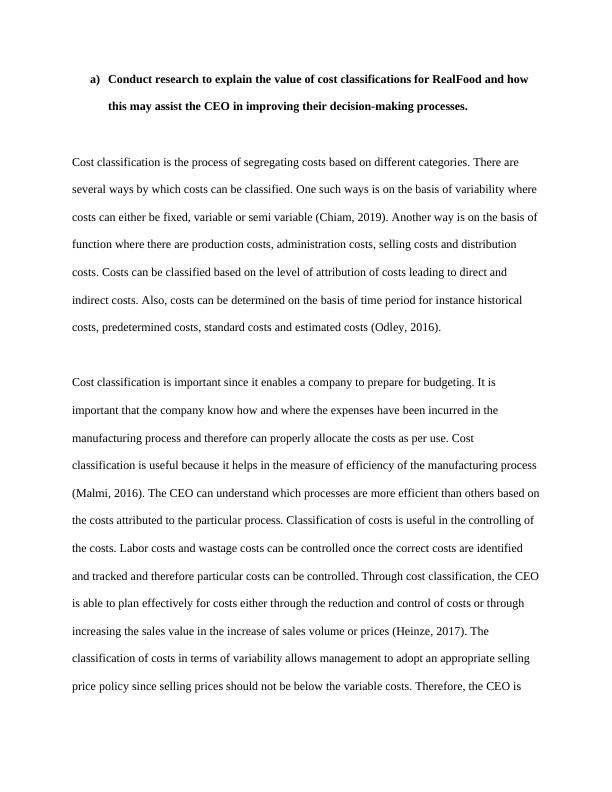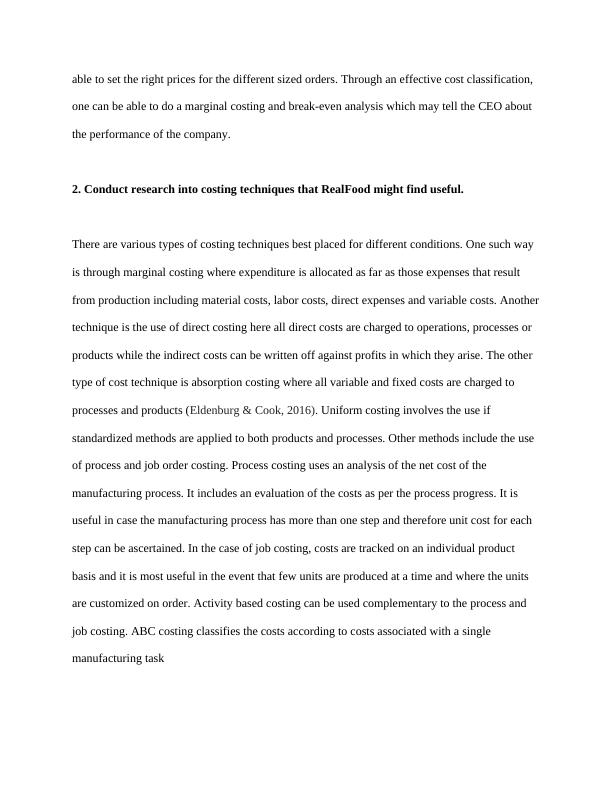The Value of Cost Classifications and Costing Techniques for RealFood
Added on 2023-06-04
6 Pages1750 Words336 Views
a) Conduct research to explain the value of cost classifications for RealFood and how
this may assist the CEO in improving their decision-making processes.
Cost classification is the process of segregating costs based on different categories. There are
several ways by which costs can be classified. One such ways is on the basis of variability where
costs can either be fixed, variable or semi variable (Chiam, 2019). Another way is on the basis of
function where there are production costs, administration costs, selling costs and distribution
costs. Costs can be classified based on the level of attribution of costs leading to direct and
indirect costs. Also, costs can be determined on the basis of time period for instance historical
costs, predetermined costs, standard costs and estimated costs (Odley, 2016).
Cost classification is important since it enables a company to prepare for budgeting. It is
important that the company know how and where the expenses have been incurred in the
manufacturing process and therefore can properly allocate the costs as per use. Cost
classification is useful because it helps in the measure of efficiency of the manufacturing process
(Malmi, 2016). The CEO can understand which processes are more efficient than others based on
the costs attributed to the particular process. Classification of costs is useful in the controlling of
the costs. Labor costs and wastage costs can be controlled once the correct costs are identified
and tracked and therefore particular costs can be controlled. Through cost classification, the CEO
is able to plan effectively for costs either through the reduction and control of costs or through
increasing the sales value in the increase of sales volume or prices (Heinze, 2017). The
classification of costs in terms of variability allows management to adopt an appropriate selling
price policy since selling prices should not be below the variable costs. Therefore, the CEO is
this may assist the CEO in improving their decision-making processes.
Cost classification is the process of segregating costs based on different categories. There are
several ways by which costs can be classified. One such ways is on the basis of variability where
costs can either be fixed, variable or semi variable (Chiam, 2019). Another way is on the basis of
function where there are production costs, administration costs, selling costs and distribution
costs. Costs can be classified based on the level of attribution of costs leading to direct and
indirect costs. Also, costs can be determined on the basis of time period for instance historical
costs, predetermined costs, standard costs and estimated costs (Odley, 2016).
Cost classification is important since it enables a company to prepare for budgeting. It is
important that the company know how and where the expenses have been incurred in the
manufacturing process and therefore can properly allocate the costs as per use. Cost
classification is useful because it helps in the measure of efficiency of the manufacturing process
(Malmi, 2016). The CEO can understand which processes are more efficient than others based on
the costs attributed to the particular process. Classification of costs is useful in the controlling of
the costs. Labor costs and wastage costs can be controlled once the correct costs are identified
and tracked and therefore particular costs can be controlled. Through cost classification, the CEO
is able to plan effectively for costs either through the reduction and control of costs or through
increasing the sales value in the increase of sales volume or prices (Heinze, 2017). The
classification of costs in terms of variability allows management to adopt an appropriate selling
price policy since selling prices should not be below the variable costs. Therefore, the CEO is

able to set the right prices for the different sized orders. Through an effective cost classification,
one can be able to do a marginal costing and break-even analysis which may tell the CEO about
the performance of the company.
2. Conduct research into costing techniques that RealFood might find useful.
There are various types of costing techniques best placed for different conditions. One such way
is through marginal costing where expenditure is allocated as far as those expenses that result
from production including material costs, labor costs, direct expenses and variable costs. Another
technique is the use of direct costing here all direct costs are charged to operations, processes or
products while the indirect costs can be written off against profits in which they arise. The other
type of cost technique is absorption costing where all variable and fixed costs are charged to
processes and products (Eldenburg & Cook, 2016). Uniform costing involves the use if
standardized methods are applied to both products and processes. Other methods include the use
of process and job order costing. Process costing uses an analysis of the net cost of the
manufacturing process. It includes an evaluation of the costs as per the process progress. It is
useful in case the manufacturing process has more than one step and therefore unit cost for each
step can be ascertained. In the case of job costing, costs are tracked on an individual product
basis and it is most useful in the event that few units are produced at a time and where the units
are customized on order. Activity based costing can be used complementary to the process and
job costing. ABC costing classifies the costs according to costs associated with a single
manufacturing task
one can be able to do a marginal costing and break-even analysis which may tell the CEO about
the performance of the company.
2. Conduct research into costing techniques that RealFood might find useful.
There are various types of costing techniques best placed for different conditions. One such way
is through marginal costing where expenditure is allocated as far as those expenses that result
from production including material costs, labor costs, direct expenses and variable costs. Another
technique is the use of direct costing here all direct costs are charged to operations, processes or
products while the indirect costs can be written off against profits in which they arise. The other
type of cost technique is absorption costing where all variable and fixed costs are charged to
processes and products (Eldenburg & Cook, 2016). Uniform costing involves the use if
standardized methods are applied to both products and processes. Other methods include the use
of process and job order costing. Process costing uses an analysis of the net cost of the
manufacturing process. It includes an evaluation of the costs as per the process progress. It is
useful in case the manufacturing process has more than one step and therefore unit cost for each
step can be ascertained. In the case of job costing, costs are tracked on an individual product
basis and it is most useful in the event that few units are produced at a time and where the units
are customized on order. Activity based costing can be used complementary to the process and
job costing. ABC costing classifies the costs according to costs associated with a single
manufacturing task

RealFood may be best placed with the use of absorption costing. This is because, since the
product ingredients are quite standardized for most of the product, the variable factors are in the
production process. First, the costs of the individual ingredients need to be established and
allocated per unit. Next the variable costs including labor and manufacturing overheads should
also be allocate as per unit basis (Fullerton & Widener, 2014). This will ensure measurement of
total variable costs per unit. In addition, since there are ingredient changes for certain product,
the use of variable cost per unit will be useful since the unique products will only have to include
the additional ingredients such as chocolate or yoghurt. Also, the organization should also
allocate for its indirect costs including electricity, sales and marketing costs. Though these costs
are not directly attributable to the product process, they are useful in the selling and
administrative process of getting the product to market (Cinquini & Tenucci, 2015). These costs
should also be allocated as per unit produced. Using this method would be easier to have a
standard price for all products and ensure that a margin can be estimated. This costing technique
is better than other techniques mentioned since it does not assume that all products are different
from each other. Also it takes into account the total costs and spreads them out depending on the
units initially produced. Compared to process costing, it assumes that the production process
does not take place in phases rather it is a smooth continuous process (Fisher & & Krumwiede,
2015).
3. Using the detail in the case, describe how your chosen method of calculating product cost
will be beneficial within RealFood and have relevance to management.
Since RealFood operates in a competitive industry, it should be able to carefully and efficiently
allocate its costs since it can ensure that it is a cost leader in the market place. In a competitive
product ingredients are quite standardized for most of the product, the variable factors are in the
production process. First, the costs of the individual ingredients need to be established and
allocated per unit. Next the variable costs including labor and manufacturing overheads should
also be allocate as per unit basis (Fullerton & Widener, 2014). This will ensure measurement of
total variable costs per unit. In addition, since there are ingredient changes for certain product,
the use of variable cost per unit will be useful since the unique products will only have to include
the additional ingredients such as chocolate or yoghurt. Also, the organization should also
allocate for its indirect costs including electricity, sales and marketing costs. Though these costs
are not directly attributable to the product process, they are useful in the selling and
administrative process of getting the product to market (Cinquini & Tenucci, 2015). These costs
should also be allocated as per unit produced. Using this method would be easier to have a
standard price for all products and ensure that a margin can be estimated. This costing technique
is better than other techniques mentioned since it does not assume that all products are different
from each other. Also it takes into account the total costs and spreads them out depending on the
units initially produced. Compared to process costing, it assumes that the production process
does not take place in phases rather it is a smooth continuous process (Fisher & & Krumwiede,
2015).
3. Using the detail in the case, describe how your chosen method of calculating product cost
will be beneficial within RealFood and have relevance to management.
Since RealFood operates in a competitive industry, it should be able to carefully and efficiently
allocate its costs since it can ensure that it is a cost leader in the market place. In a competitive

End of preview
Want to access all the pages? Upload your documents or become a member.
Related Documents
Cost Accounting - Direct cost and Indirect costlg...
|30
|7186
|23
Management Accounting: Absorption Costing vs Marginal Costinglg...
|10
|376
|123
Using Cost Information for Budgeting and Forecasting in the Management Accountinglg...
|18
|4731
|226
Management Accounting Requirementlg...
|9
|1508
|25
Performance Management Cost & Management Accountinglg...
|7
|1173
|346
Report on Management Accounting Informationlg...
|18
|4077
|127
